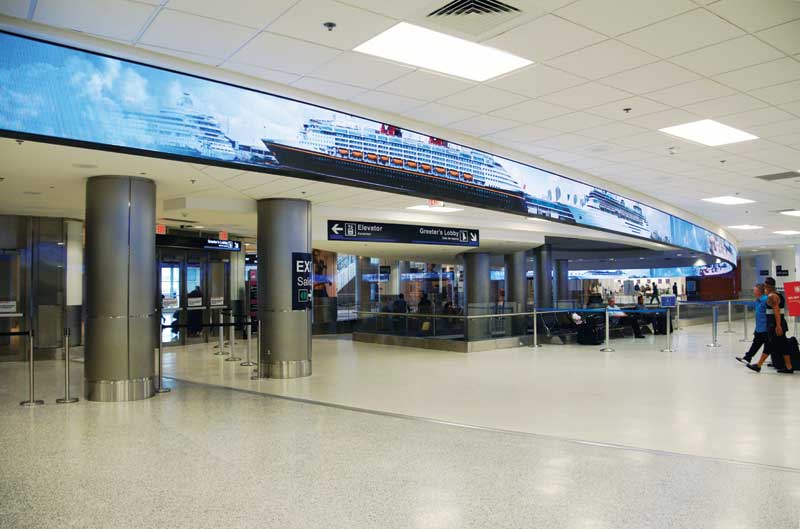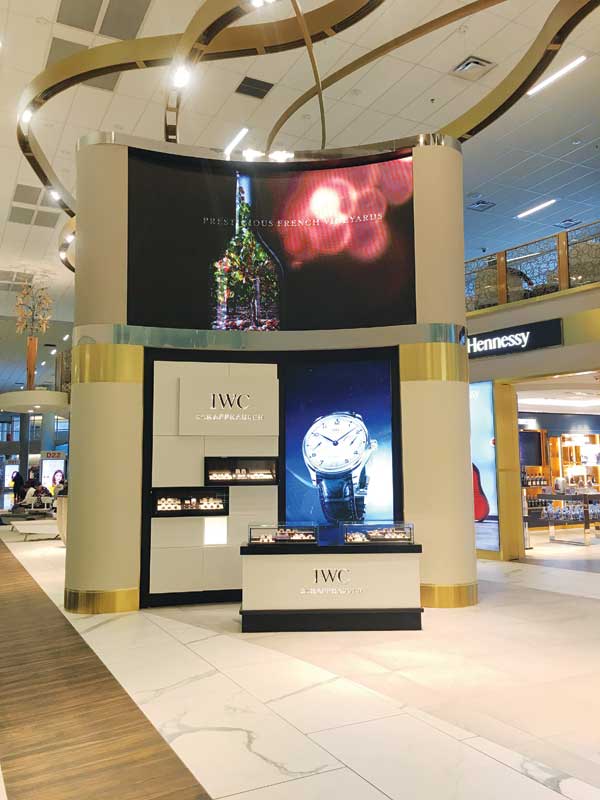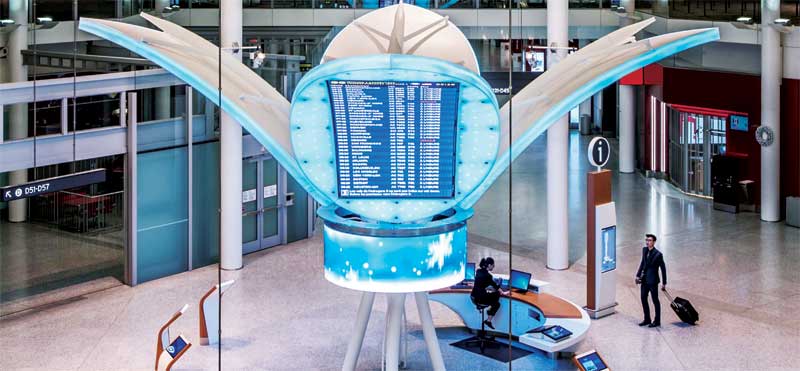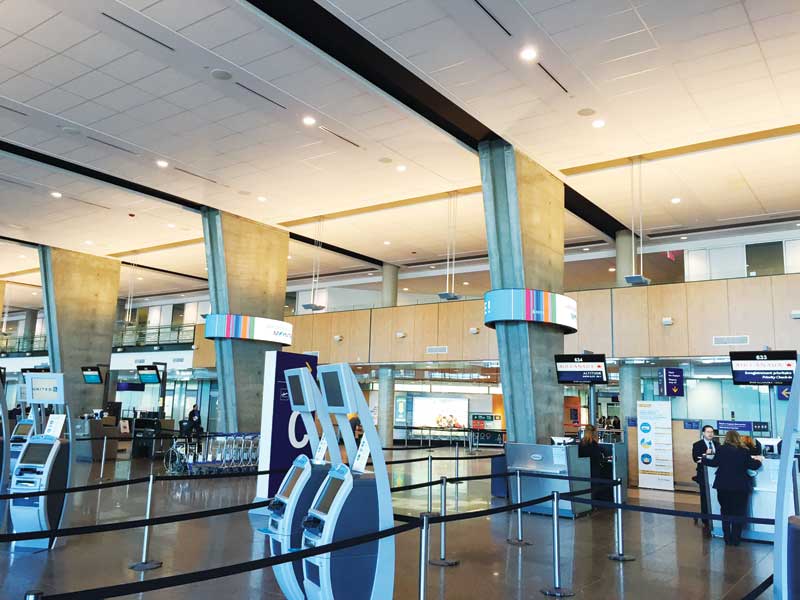Digital Signage: Energizing airports with LED displays
by all | 18 May 2018 10:00 am
 [1]
[1]Photos courtesy NanoLumens
By Brett Farley
While airports have not typically been seen as stand-alone destinations in their own right, the simplification of their purpose need not relegate them to serving exclusively as character-free gateways for passengers travelling from point A to point B. If the practical and artistic philosophies behind the design and operation of today’s airports are re-evaluated and refreshed, then they can become places worth going to, not just going through.
Indeed, many of today’s airport executives are seeking to optimize the value of the public’s time in their facilities, not only to make them stand out, but also to maximize their generation of additional revenue, through versatile and sustainable means. As they re-engineer the way their terminals look, feel and operate, light-emitting diode (LED) display technology is particularly well-positioned to help them reach their goals.
Improving the passenger experience
A recent study showed 83 per cent of airport travellers sought out flight information prior to transit, but only 58 per cent of airports were doing an adequate job of providing that information. Solving this problem requires a better understanding of how the travellers move throughout the airports.
Flight information display systems (FIDSs) use data that is constantly in flux, as planes encounter delays, change gates, etc. Simply by increasing the visibility and accessibility of these digital screens, e.g. by making them bigger and brighter, airports can better-inform their passengers.
The Greater Toronto Airport Authority (GTAA), for example, recently commissioned Stantec to design and Eventscape to manufacture a 7.6-m (25-ft) tall steel structure, shaped like a flower. Each of its four ‘petals’ supports a 3.7 x 1.5-m (12 x 5-ft) liquid crystal display (LCD), which displays flight information. There is also an LED ring display covering the two central connecting rings of the flower’s ‘stems,’ which shows the current weather.
This unique project dominates a central gathering area of Terminal 1 at Toronto’s Pearson International Airport. It has transformed what was once dead space into one of the busiest locations in the entire concourse. Airport personnel say they frequently overhear travellers telling each other, “Meet me at the flower.” As such, in addition to serving the practical purpose of providing flight information, it has enlivened the passenger experience by creating a new landmark within the airport.
 [2]
[2]Curved LED displays showcase brands and duty-free products in a redesigned retail area at Texas’ Dallas/Fort Worth International Airport.
Of course, travellers in an airport are not always going to be standing still, nor will they be viewing each FIDS from a single, predictable point. To minimize this problem, today’s LED displays include models that can be seen clearly at a wider variety of distances and angles, keeping content legible for a non-stationary, off-axis audience.
At Georgia’s Hartsfield-Jackson Atlanta International Airport, for example, a dimly lit LCD that used to force passengers to congregate in a scrum to read flight information was recently replaced with a much brighter LED display. As crowds can read it from further distances and wider angles, they are more dispersed and foot traffic flows more efficiently.
Beyond flight updates, wayfinding directions are also more clearly visible when displayed on LED screens. When Vancouver International Airport’s international arrival customs terminal was renovated, a 9.8 x 2.7-m (32 x 9-ft) LED display was added to help welcome first-time visitors by providing clear and relevant information about where to proceed from their gate.
The dynamic nature of digital signage is also helpful where more than one language is needed. By way of example, on-screen content could be changed based on the primary language(s) of the country of origin for flights arriving at a certain gate.
In all of these ways, LED displays can improve the passenger experience, presenting information in an attractive fashion that lets visitors glance and be on their way.
 [3]
[3]A flower-shaped digital signage structure has become a landmark within Toronto’s Pearson International Airport.
Artistic possibilities
As airports are often the first thing a traveller sees upon arriving in a new city, they also serve an important role in communicating and celebrating the culture of the regions they service. Modern airport design has embraced the cultivation of an immersive and local sense of place, incorporating elements of art and heritage.
The aforementioned flower-shaped structure at Pearson International Airport, for example, somewhat resembles the white trillium, the provincial flower of Ontario. At Singapore’s Changi Airport, meanwhile, two prominent LED-based ‘digital murals’ that display images of the city-state’s history and culture recently won a 2018 InAVation Award in the transport category for Electronics & Engineering (E&E), which developed them in partnership with Montreal-based Moment Factory.
“We are honoured to receive this international award and thank the Changi Airport team, who had the vision and commitment to create a totally new standard for the passenger experience,” says Gary Goh, E&E’s deputy managing director.
Most recently, at Vancouver International Airport, a 3.8 x 2.4-m (12.5 x 7.8-ft) LED display was installed to entertain travellers waiting in line with images of the city’s scenery that move in response to their gestures, as captured by a Microsoft Kinect system and camera. Montreal-based Float4 developed the interactive content for the display, which replaces an earlier, printed map of select flight paths.
“Passengers and employees are loving it,” says Lynette DuJohn, the Vancouver Airport Authority’s (VAA’s) vice-president (VP) of information technology (IT) and chief digital officer (CDO). “We are seeing a lot of smiles on people’s faces!”
 [4]
[4]At Montreal’s Pierre Elliott Trudeau International Airport, two 360-degree ‘halo’ digital displays have visually transformed otherwise unadorned building columns.
Some airports’ art directors are given annual budgets for beautifying their concourses and terminals with art installations. Increasingly, they realize this capital can be more efficiently spent on dynamic digital signage content than on changing out static artwork time and again.
Unlike LCDs, LED displays can be custom-built in any size, shape or curvature, allowing for creative designs and for seamless integration with existing architecture. At Montreal’s Pierre Elliott Trudeau International Airport, for example, two 360-degree ‘halo’ displays, each measuring 7.3 x 0.6 m (24 x 2 ft), were installed at the U.S. transborder departure gate to transform unadorned building columns into eye-catching attractions.
Further, the brightness of LED displays means they can be installed in airport concourses that are flooded with natural light and still be seen clearly enough.
 [5]
[5]Montreal-based Moment Factory helped develop LED-based ‘digital murals’ for Singapore’s Changi Airport, which went on to win a 2018 InAVation.
Maximizing revenue
Beyond their practical use in displaying flight information and wayfinding directions and their cultural and artistic potential, LED displays can be effective in generating new revenue for airports through digital out-of-home (DOOH) advertising.
Airport displays are typically quite large, with plenty of room for a combination of information and advertising. An installation at Terminal 4 of New York’s John F. Kennedy International Airport, for example, primarily displays flight information on one side for people waiting outside for arriving travellers, while the other side often showcases ads to those travellers as they arrive.
A major redesign of the duty-free shopping area of Terminal D at Texas’ Dallas/Fort Worth International Airport has added three huge, curved LED displays that allow ads to better capture the attention of passersby. Among these is a 5.5 x 3.2-m (18 x 10.5-ft) screen surrounding a ‘promo pod,’ where advertisers can showcase their product with exclusivity.
“Nothing compares to a display so big you can walk inside it,” says Sean Kupiec, project manager for Ford AV, the technology integrator.
The other two displays, each measuring 3.7 x 2.1 m (12 x 7 ft), adorn the top of a product kiosk along the main terminal walkway.
“They can be seen from 30.5 m (100 ft) away,” says Kupiec. “Such eye-catching technology brings more people in and makes them excited to experience the store.”
Brett Farley is director of strategic business development for NanoLumens, which manufactures LED-based digital displays, including all of those mentioned in this article. For more information, visit www.nanolumens.com[6].
- [Image]: https://www.signmedia.ca/wp-content/uploads/2018/05/LED_MiamiFL_17.jpg
- [Image]: https://www.signmedia.ca/wp-content/uploads/2018/05/LED_IMG_1464.jpg
- [Image]: https://www.signmedia.ca/wp-content/uploads/2018/05/LED_TorontoPearsonAirport_Toronto_10.jpg
- [Image]: https://www.signmedia.ca/wp-content/uploads/2018/05/LED_Montreal-Airport_QuebecCanada_7.jpg
- [Image]: https://www.signmedia.ca/wp-content/uploads/2018/05/LED_Heritage-Zone.jpg
- www.nanolumens.com: http://www.nanolumens.com
Source URL: https://www.signmedia.ca/digital-signage-energizing-airports-with-led-displays/